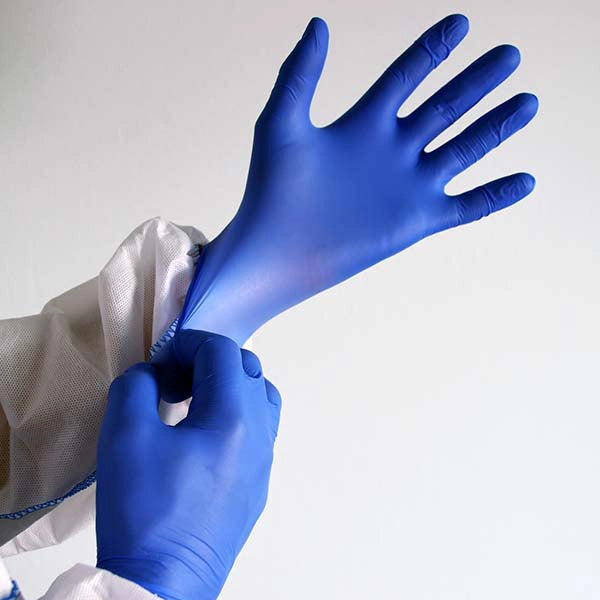The short answer? Yes, nitrile gloves are made without latex.
While latex gloves have been valued for well over a hundred years to protect hands in a variety of industries, nitrile gloves have become increasingly popular over the past few decades.
Ask most people what nitrile gloves are made of or what they’re good for, though, and you’ll probably be met with a shrug.
In this article, we’ll help shed some light on how nitrile gloves are made, the situations in which you might want to avoid latex, and where you can get your, uh, hands on some of the best nitrile gloves on the market.
By the end of the article, you’ll be the life of every cocktail party with all of your nitrile knowledge. All jokes aside, you’ll also have a great idea of whether nitrile gloves are right for you.
At a glance:
What are Disposable Nitrile Gloves Made Of?
Nitrile is a synthetic copolymer, known as nitrile-butadiene rubber. Simple, right?
OK, if you’re like most of us and you have no idea what we just said, let’s break it down: a copolymer is simply a material made of two molecules bonded together. In the case of nitrile, the two molecules involved are acrylonitrile and butadiene.
The process is chemically complex compared to latex, which is a naturally occurring substance found in the rubber tree (and 10% of all plant life).
That complexity doesn’t translate to costs, however. In the 40 or so years since nitrile gloves were invented, technological advancements have made them just as affordable as latex gloves.
Latex free nitrile gloves also manage to offer similar touch sensitivity and abrasion resistance as latex gloves and, in some cases, even better chemical resistance.
The important takeaway here, though, is that nitrile gloves are latex free.
Why Use Latex-Free Gloves?
If you’re asking ‘are nitrile gloves latex free,’ chances are you might be worried about allergies.
Latex allergies are a relatively common, but potentially serious health issue, especially for healthcare workers and their patients. Depending on the person, allergic reactions to latex can range from mild discomfort to the development of rashes to anaphylactic shock and death.
While latex gloves have been used in surgery for over 150 years, it wasn’t until the late 1980’s and 90’s that the prevalence of allergies to them began to grow, thanks to an increased use of them in many other healthcare settings for protection against bloodborne pathogens.
According to the Journal of Occupational Health, around 4-5% of the general population suffers from latex allergies. Thanks to repeated exposure, that number’s even higher among healthcare workers, with about 9-10% having some kind of reaction.
Allergies are a significant risk, but they’re not the only reason why you may want to choose latex free nitrile gloves:
- Durability - While latex gloves are resistant to tearing thanks to their natural rubber content, the synthetic rubber in latex free nitrile gloves or neoprene disposable gloves can be even more puncture resistant.
- Versatility - Latex free gloves can be better suited to a wide range of situations. Vinyl gloves can be a better choice for some food service and cleaning applications due to their lower costs, and nitrile gloves can be suitable for automotive work where their increased durability is useful.
- Chemical Resistance - Nitrile gloves and some other gloves are more resistant to a range of chemicals, oils, and acids than natural rubber latex gloves. That makes them a great choice as personal protective equipment for workplaces where those chemicals are present.
- Reduced Risk of Sensitization - This goes along with the point about allergies we made earlier, but using non-latex gloves means less exposure and thus less of a chance of developing latex allergies if you don’t already.
- Equal Performance - In terms of comfort, tactile sensitivity, and protection against infection, nitrile gloves perform similarly to latex gloves in most situations in which you’d use either type of disposable glove.
One important thing to note: just because a pair of disposable gloves are latex free doesn’t mean they’re allergen free.
To avoid skin irritation, it’s also important to look for gloves that are both latex-free and powder-free when shopping for latex glove alternatives. Powder is often used to make donning disposable gloves easier, but it can also cause rashes itself.
Where to Buy Latex Free Nitrile Gloves

At this point, you may have already googled this question and have seen endless Amazon listings for a bunch of nitrile disposable gloves of questionable quality sold under a variety of difficult to pronounce brand names in capital letters.
Or maybe you’ve checked a medical or industrial supply website and seen the high-quality, but high-priced gloves that professionals sometimes use. Perhaps you’ve even logged off and checked out the limited selection at your local hardware store or big box store.
Any of these places can be solid choices for shopping for nitrile gloves (in some cases, even the dodgy-looking Amazon sellers are OK!). They’ve all got their compromises, though.
The best place to find high quality, latex free gloves you can trust to get the job done is a dedicated online glove retailer like, well, us.
For over 30 years, we’ve been proud to offer a selection of the highest quality nitrile gloves on the market at affordable, wholesale prices. No matter what your use case is, we’ve got the glove to match it. Check out our selection today to find your new favorite pair.




